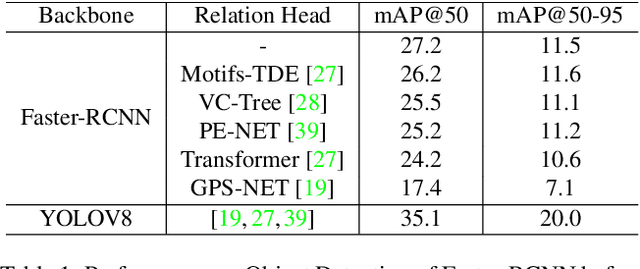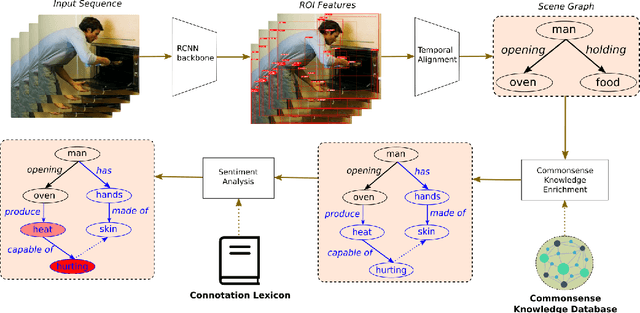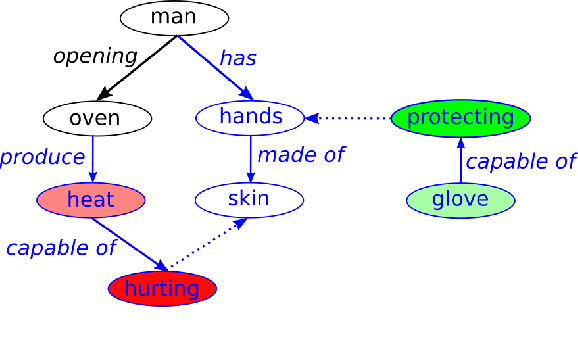Anne-Gwenn Bosser
Lab-STICC\_COMMEDIA, ENIB, Lab-STICC
What killed the cat? Towards a logical formalization of curiosity (and suspense, and surprise) in narratives
Oct 11, 2024

Abstract:We provide a unified framework in which the three emotions at the heart of narrative tension (curiosity, suspense and surprise) are formalized. This framework is built on nonmonotonic reasoning which allows us to compactly represent the default behavior of the world and to simulate the affective evolution of an agent receiving a story. After formalizing the notions of awareness, curiosity, surprise and suspense, we explore the properties induced by our definitions and study the computational complexity of detecting them. We finally propose means to evaluate these emotions' intensity for a given agent listening to a story.
Real-Time Scene Graph Generation
May 25, 2024



Abstract:Scene Graph Generation (SGG) can extract abstract semantic relations between entities in images as graph representations. This task holds strong promises for other downstream tasks such as the embodied cognition of an autonomous agent. However, to power such applications, SGG needs to solve the gap of real-time latency. In this work, we propose to investigate the bottlenecks of current approaches for real-time constraint applications. Then, we propose a simple yet effective implementation of a real-time SGG approach using YOLOV8 as an object detection backbone. Our implementation is the first to obtain more than 48 FPS for the task with no loss of accuracy, successfully outperforming any other lightweight approaches. Our code is freely available at https://github.com/Maelic/SGG-Benchmark.
Fine-Grained is Too Coarse: A Novel Data-Centric Approach for Efficient Scene Graph Generation
May 30, 2023



Abstract:Learning to compose visual relationships from raw images in the form of scene graphs is a highly challenging task due to contextual dependencies, but it is essential in computer vision applications that depend on scene understanding. However, no current approaches in Scene Graph Generation (SGG) aim at providing useful graphs for downstream tasks. Instead, the main focus has primarily been on the task of unbiasing the data distribution for predicting more fine-grained relations. That being said, all fine-grained relations are not equally relevant and at least a part of them are of no use for real-world applications. In this work, we introduce the task of Efficient SGG that prioritizes the generation of relevant relations, facilitating the use of Scene Graphs in downstream tasks such as Image Generation. To support further approaches in this task, we present a new dataset, VG150-curated, based on the annotations of the popular Visual Genome dataset. We show through a set of experiments that this dataset contains more high-quality and diverse annotations than the one usually adopted by approaches in SGG. Finally, we show the efficiency of this dataset in the task of Image Generation from Scene Graphs. Our approach can be easily replicated to improve the quality of other Scene Graph Generation datasets.
Commonsense Reasoning for Identifying and Understanding the Implicit Need of Help and Synthesizing Assistive Actions
Feb 23, 2022

Abstract:Human-Robot Interaction (HRI) is an emerging subfield of service robotics. While most existing approaches rely on explicit signals (i.e. voice, gesture) to engage, current literature is lacking solutions to address implicit user needs. In this paper, we present an architecture to (a) detect user implicit need of help and (b) generate a set of assistive actions without prior learning. Task (a) will be performed using state-of-the-art solutions for Scene Graph Generation coupled to the use of commonsense knowledge; whereas, task (b) will be performed using additional commonsense knowledge as well as a sentiment analysis on graph structure. Finally, we propose an evaluation of our solution using established benchmarks (e.g. ActionGenome dataset) along with human experiments. The main motivation of our approach is the embedding of the perception-decision-action loop in a single architecture.
 Add to Chrome
Add to Chrome Add to Firefox
Add to Firefox Add to Edge
Add to Edge